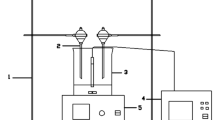Abstract
Photocatalysis of a hollandite compound K x Ga x Sn8−x O16 (x = ca. 1.8) was examined for the reduction of nitrate to N2 with a reducing agent of methanol in water under UV irradiation. Hollandites have a characteristic one-dimensional tunnel structure. The meso-porous hollandite was prepared by sol-gel method. This hollandite was used as the photocatalyst and its reaction process was quantitatively analyzed by using ion chromatograph and on-line mass spectrometry. The hollandite photocatalyst showed a significant activity for the formation of N2 from NO −3 . Two factors, an increase in UV intensity and a lowering in pH of the solution, contributed to improvement in the selectivity for N2. The selectivity for N2 was improved to reach the perfect level by adjusting the factors. Although, in the previous report, the nitrate was mainly reduced to NH +4 or NO −2 , the present photocatalytic conditions converted it to N2. The observed photocatalytic reduction of NO −3 to N2 with reducing agent CH3OH was conjugated to the partial oxidation of CH3OH to HCOOH. This high selective photocatalytic decomposition of NO −3 to N2 may be a new pathway among the others reported so far, and it would be useful for environmental protection of water.
Similar content being viewed by others
References
C.J. Johnson and B.C. Kross, Am. J. Ind. Med. 18, 448 (1990).
I. Nakamura, Sei Marianna Ika Daigaku Zasshi 18, 413 (1990).
P. Chambon, L. Coin, and J. Vial, J. Tech. Eau. Assainissement 438/439, 33 (1983).
M.A. Fox and M.T. Dulay, Chem. Rev. 93, 341 (1993).
P.V. Kamat, Chem. Rev. 93, 267 (1993).
K. ashimoto and A. Fujishima, Catalysis 36, 524 (1994).
D. Duonghong, E. Borgarello, and M. Gratzel, J. Am. Chem. Soc. 103, 4685 (1981).
S. Hashimoto, S.G. Zhang, H. Yamashita, Y. Souma, and M. Anpo, Chem. Lett. 11, 1127 (1997).
H. Yamashita, Y. Ichihashi, S.G. Zhang, Y. Matsumura, Y. Souma, T. Tatsumi, and M. Anpo, Applied Surface Science 121/122, 305 (1997).
A. Kudo, K. Domen, K. Maruyama, and T. Onishi, Chem. Lett. 6, 1019 (1987).
K.T. Ranjit, R. Krishnamoorthy, and B. Viswanathan, J. Photochemistry and Photobiology A: Chemistry 81, 55 (1994).
M. Watanabe, T. Mori, S. Yamauchi, and H. Yamamura, Solid State Ionics 102, 376 (1994).
T. Mori, S. Yamauchi, H. Yamamura, and M. Watanabe, Appl. Cat. A: Gen. 129, L1 (1995).
T. Mori, S. Yamauchi, H. Yamamura, and M. Watanabe, J. Mater. Sci. 31, 1469 (1996).
T. Mori, J. Suzuki, K. Fujimoto, and M. Watanabe, J. Material Synthesis and Processing 6, 329 (1998).
A. Bystrom and A.M. Bystrom, Acta Cryst. 3, 146 (1950).
Y. Fujiki, S. Takenouchi, Y. Onoda, M. Watanabe, S. Yoshikado, T. Ohachi, and I. Taniguchi, Solid State Ionics 25, 131 (1998).
K. Fujimoto, M. Watanabe, T. Mori, and S. Ito, J. Mater. Res. 13, 926 (1998).
Author information
Authors and Affiliations
Rights and permissions
About this article
Cite this article
Mori, T., Suzuki, J., Fujimoto, K. et al. Photocatalytic Reduction of Nitrate in Water on Meso-Porous Hollandite Catalyst: A New Pathway on Removal of Nitrate in Water. Journal of Sol-Gel Science and Technology 19, 505–510 (2000). https://doi.org/10.1023/A:1008724219384
Issue Date:
DOI: https://doi.org/10.1023/A:1008724219384




